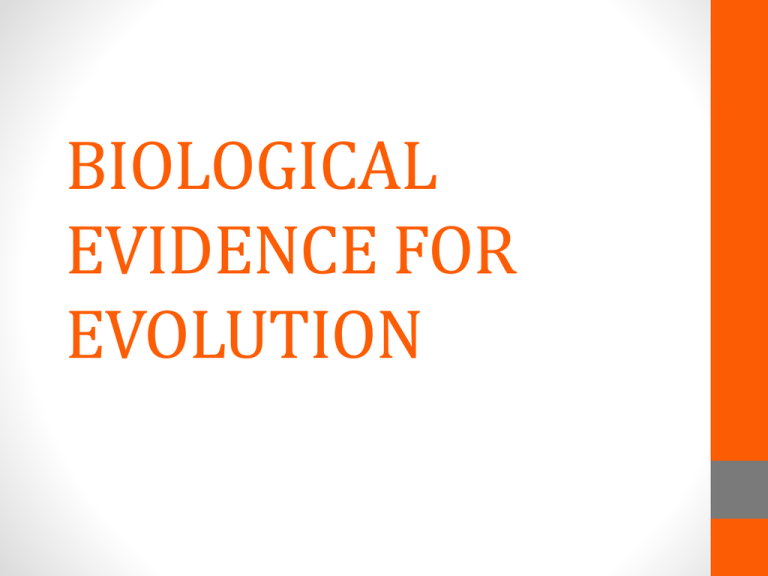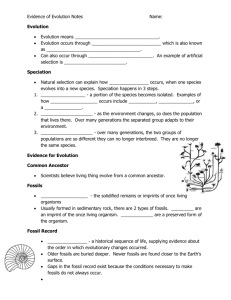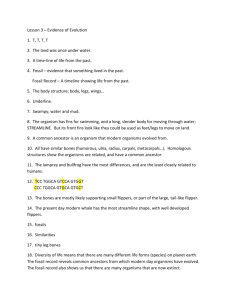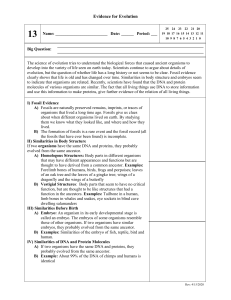DARWIN AND THE THEORY OF EVOLUTION
advertisement

BIOLOGICAL EVIDENCE FOR EVOLUTION The First Organic Molecules • All living things consist of organic molecules. • How did these building blocks of life first form? Scientists think that lightning sparked chemical reactions in Earth’s early atmosphere. They hypothesize that this created a ‘‘soup” of organic molecules from inorganic chemicals. In 1953, scientists Stanley Miller and Harold Urey used their imaginations to test this hypothesis. They created a simulation experiment to see if organic molecules could arise in this way . They used a mixture of gases to represent Earth’s early atmosphere. Then, they passed sparks through the gases to represent lightning. Within a week, several simple organic molecules had formed. Which Organic Molecule Came First? DNA or Proteins • Living things need DNA molecules to store genetic information and to carry out the chemical work of cells. • Modern organisms use DNA to store genetic information and proteins to catalyze chemical reactions. • So, did DNA or proteins evolve first? • This is like asking whether the chicken or the egg came first. • DNA encodes proteins and proteins are needed to make DNA, so each type of organic molecule needs the other for its own existence. • How could either of these two molecules have evolved before the other? • Did some other organic molecule evolve first, instead of DNA or proteins? RNA World Hypothesis • Some scientists speculate that RNA may have been the first organic molecule to evolve. • In fact, they think that early life was based solely on RNA and that DNA and proteins evolved later. • Why RNA? It can encode genetic instructions (like DNA), and some RNAs can carry out chemical reactions (like proteins). • Therefore, it solves the chicken-andegg problem of which of these two molecules came first. • Other evidence also suggests that RNA may be the most ancient of the organic molecules. The First Cells • Scientists speculate that lipid membranes grew around the organic molecules. The membranes prevented the molecules from reacting with other molecules, so they did not form new compounds. In this way, the organic molecules persisted, and the first cells may have formed. LUCA • No doubt there were many early cells of this type. However, scientists think that only one early cell (or group of cells) eventually gave rise to all subsequent life on Earth. That one cell is called the Last Universal Common Ancestor (LUCA). It probably existed around 3.5 billion years ago. LUCA was one of the earliest prokaryotic cells. It would have lacked a nucleus and other membrane-bound organelles. Photosynthesis and Cellular Respiration The earliest cells were probably heterotrophs. Most likely they got their energy from other molecules in the organic ‘‘soup.” However, by about 3 billion years ago, a new way of obtaining energy evolved. This new way was photosynthesis. Through photosynthesis, organisms could use sunlight to make food from carbon dioxide and water. These organisms were the first autotrophs. They provided food for themselves and for other organisms that began to consume them. After photosynthesis evolved, oxygen started to accumulate in the atmosphere. This has been dubbed the ‘‘oxygen catastrophe.” Why? Oxygen was toxic to most early cells because they had evolved in its absence. As a result, many of them died out. The few that survived evolved a new way to take advantage of the oxygen. This second major innovation was cellular respiration. It allowed cells to use oxygen to obtain more energy from organic molecules. Evolution of Eukaryotes • The first eukaryotic cells probably evolved about 2 billion years ago. This is explained by endosymbiotic theory. Endosymbiosis came about when large cells engulfed small cells. The small cells were not digested by the large cells. Instead, they lived within the large cells and evolved into cell organelles. Fossil Evidence • Fossils are a window into the past because it is the remains or traces of an organisms that died many years ago. They provide clear evidence that evolution has occurred. • Scientists who find and study fossils are called paleontologists. • The fossils themselves have been formed in many different ways. Fossils are the preserved remains or traces of organisms that lived in the past. The soft parts of organisms almost always decompose quickly after death. On occasion, the hard parts—mainly bones, teeth, or shells—remain long enough to mineralize and form fossils. One way fossils are formed is when an organism’s remains fall into soft mud or sand and are buried leaving behind an impression. The mud or sand hardened into rock over time preserving the impression of the fallen organism. Another way fossils can be formed is when a whole organism gets trapped and preserved in substances, like tar, amber, or ice. Fossils formed in these two ways are typically known as body fossils. FOSSILS Fossil Impressions Preserved FossilsBody Fossils Deciphering the Age of Fossils • Today we ascertain the age of a fossil using the Geologic Time Scale, which was developed in the 1700s by geologists. The development of the Geologic Time Scale is based upon the principle of superposition developed by a Danish scientists Nicolaus Steno in 1669. • The principle of superposition states that if strata (layers of rock) at a location have not been disturbed, the lowest stratum (singular form of strata) was formed before the strata above it. Using the Dating Methods • Relative dating determines which of two fossils is older or younger than the other, but not their age in years. Relative dating is based on the positions of fossils in rock layers. Lower layers were laid down earlier, so they are assumed to contain older fossils. • Absolute dating determines about how long ago a fossil organism lived. This gives the fossil an approximate age in years. Absolute dating is often based on the amount of carbon-14 or other radioactive element that remains in a fossil. Evidence from Living Species Comparative Anatomy • Study of the similarities and differences in the structures of different species. Similar body parts may be homologies, analogies, or vestigial structures. • Homologies or homologous structures are structures that are similar in related organisms because they were inherited from a common recent ancestor. These homologous structures or homologous organs may or may not have the same function in the descendants. • Analogies or analogous structures are structures that are similar in unrelated organisms. The structures are similar because they evolved to do the same job, not because they were inherited from a common ancestor. • Vestigial structures are structures that seem to serve no function but resemble structures with functionality in related organisms. Evolution has reduced their size because the structures are no longer used. The mostly widely known example of this is the human tailbone, or coccyx, that is made up of four fused vertebrae similar in structure to the bones in the tails of animals. Comparative Embryology • Comparative embryology is the study of the similarities and differences in the embryos of different species. Similarities in embryos are evidence of common ancestry. All vertebrate embryos, for example, have gill slits and tails. All of the animals in the figure, except for fish, lose their gill slits by adulthood. Some of them also lose their tail. In humans, the tail is reduced to the tail bone. Thus, similarities organisms share as embryos may be gone by adulthood. This is why it is valuable to compare organisms in the embryonic stage. Comparing Biological Molecules • Scientists can compare DNA, RNA, proteins, and other biological molecules from a variety of organisms. As they study these different biological molecules they look for similarities and differences. The more similarities found in biological molecule make-up between two different species the more closely the species are related to one another through a common ancestor. Similar DNA sequences are the strongest evidence for evolution from a common ancestor. Further Evidence for Common Ancestry -Universal Genetic Code and Molecular Clocks Universal Genetic Code • The instructions for life are encoded in our DNA. • All organisms contain the same 4 nitrogenous bases in their DNA molecules, Adenine (A), Thymine (T), Cytosine (C), and Guanine (G). • While all organisms contain the same bases, the quantities and sequences of these bases differs from one species to another and these differences account for the different traits each species exhibits. • The fact that all organisms encode the directions for inheritance in DNA molecules and share a universal genetic code suggests they all share a common ancestor. • Codons of DNA code for the same amino acids regardless of the species in which the DNA exists. Molecular Clocks • Evidence from the fossil record can be combined with data from molecular clocks. • A molecular clock uses DNA sequences (or the proteins they encode) to estimate how long it has been since related species diverged from a common ancestor. • Molecular clocks are based on the assumption that mutations accumulate through time at a steady average rate for a given region of DNA. • Species that have accumulated greater differences in their DNA sequences are assumed to have diverged from their common ancestor in the more distant past. Table~: Comparing DNA: Humans and Other Animals ------------------------------------------------------------------------------------Organism Similarity with Human DNA (percent) ------------------------------------------------------------------------------------Chimpanzee 98 Mouse 85 Chicken 60 Fruit Fly 44 ------------------------------------------------------------------------------------- According to this molecular clock data, which species is most closely related to humans???? Lesson Summary • Earth formed about 4.6 billion years ago. At first, Earth was molten and lacked an atmosphere and oceans. Gradually, the atmosphere formed, followed by the oceans. • The first organic molecules formed about 4 billion years ago. This may have happened when lightning sparked chemical reactions in Earth’s early atmosphere. RNA may have been the first organic molecule to form as well as the basis of early life. • The first cells consisted of little more than an organic molecule such as RNA inside a lipid membrane. One cell (or group of cells), called the last universal common ancestor (LUCA), gave rise to all subsequent life on Earth. • Photosynthesis evolved by 3 billion years ago and released oxygen into the atmosphere. Cellular respiration evolved after that to make use of the oxygen. • Eukaryotic cells probably evolved about 2 billion years ago. Their evolution is explained by endosymbiotic theory. Eukaryotic cells would go on to evolve into the diversity of eukaryotes we know today. • Fossils provide a window into the past. They are evidence for evolution. Scientists who find and study fossils are called paleontologists. • The geologic time scale is another important tool for understanding the history of life on Earth. • Scientists compare the anatomy, embryos, and DNA of living things to understand how they evolved. Evidence for evolution is provided by homologous structures. These are structures shared by related organisms that were inherited from a common ancestor. Other evidence is provided by analogous structures. These are structures that unrelated organisms share because they evolved to do the same job. • Much of what we know about the history of life on Earth is based on the fossil record. Molecular clocks are used to estimate how long it has been since two species diverged from a common ancestor.






